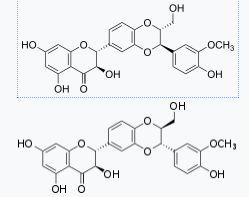Old chemicals from a very old plant that continues to surprise: Silymarin and Milk Thistle
From my glossary, The Chemicals Life Makes” (you can find it here)
Silymarin
Antioxidant, chemopreventive
Silymarin, a heterogenous extract of Silybum marianum (milk thistle) may be as effective as RetinA without the irritation. Silymarin has multiple beneficial effects on the skin, protecting it from a variety of environmental agents. Research has shown that silymarin reduces the effects of toxins on epidermal cells; as an antioxidant, it prevents the oxidative damage to DNA caused by UV radiation, and it protects against chemically induced skin tumors in mice. Recent research looked at the mechanism by which silymarin prevents skin cancer and it seems that it normalizes the function of a “deranged” cell membrane receptor. These multiple functions make silymarin an ideal ingredient for skincare and skin cancer prevention.
Note: For people who have used benzoyl peroxide (BPO) in the past (I hope none of our clients use it at present) silymarin may help inhibit BPO-induced skin edema, myeloperoxidase activity, and interleukin-1 protein levels in the epidermis, possibly helping prevent BPO-caused skin cancer.

Figure: Silybum Marianum, a.k.a. milk thistle, St. Mary’s thistle. Illustration by Maria Sibylla Merian (entomologist and artist, 1647-1717)
Silybum marianum has other common names including cardus marianus and milk thistle. The seeds extract has been used for centuries to help with liver ailments. This is a good example of why to use standardized extracts and not just herbal supplements bought somewhere: milk thistle extract can be contaminated with mycotoxins, i.e. toxins produced by fungi that grow alongside the plant.
Silymarin
Silybum marianum seed extract, called silymarin, is a complex mixture of polyphenolic molecules, including seven closely related flavonolignans (silybin A, silybin B, isosilybin A, isosilybin B, silychristin, isosilychristin, silydianin), and one flavonoid, taxifolin.
Figure: silybin A and B.
And what can silymarin do?
Its benefits on liver disease have been studied extensively. It has been suggested that its benefits include anticancer, anti-Alzheimer, anti-Parkinson, and anti-diabetic activities but “great power demands great evidence” and were are not there yet.
Silibinin also has a number of activities that benefit the skin. These include chemoprotective effects from environmental toxins, anti-inflammatory activity, protection from UV-induced photocarcinogenesis, protection from sunburn, protection from UVB-induced epidermal hyperplasia, and enhanced DNA repair for UV-induced DNA damage (double-strand breaks). Chemoprevention with retinoids and silymarin may help prevent actinic keratosis.
Silymarin protects skin immunity against the detrimental effects of UV light.
Mechanisms of action
Photoprotective effects of some selected polyphenols on UV-induced skin inflammation, proliferation, immunosuppression, DNA damage and dysregulation of important cellular signaling pathways and their implications in skin cancer management polyphenols silymarin, supports their potential use in skin photoprotection and prevention of photocarcinogenesis in humans.
Polyphenols, in general, repair UV-induced DNA damage through enhancement of nucleotide excision repair (NER) genes
The antioxidant and protective activities are probably related to the activation of the nuclear factor erythroid 2 (NFE2)-related factor 2 (Nrf2), known as a master regulator of the cytoprotective response. Nrf2 is a redox-sensitive nuclear transcription factor able to induce the downstream-associated genes. The disruption of Nrf2 signaling has been associated with different pathological conditions.
Take-home lesson?
Use silymarin topically, it’s worth it! Old and proven, no side effects but multiple benefits!
Silymarin for Do It Yourself: find it here
Silymarin in Skin Actives UV Repair Cream find it here.
Afaq F, Katiyar SK. (2011) Polyphenols: skin photoprotection and inhibition of photocarcinogenesis. Mini Rev Med Chem. 11:1200-1215.
Nichols, J. A., & Katiyar, S. K. (2009). Skin photoprotection by natural polyphenols: anti-inflammatory, antioxidant and DNA repair mechanisms. Archives of Dermatological Research, 302:71–83.
Claims on this page have not been evaluated by the FDA and are not intended to diagnose, cure, treat or prevent any disease.
